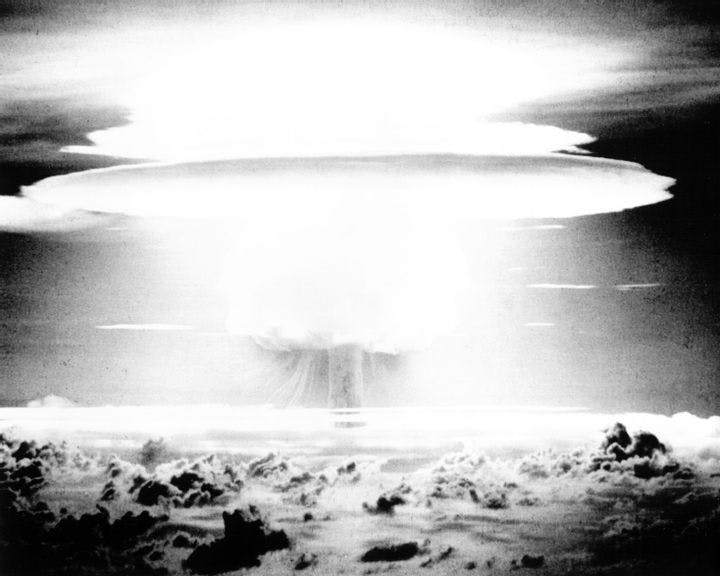Summer 2011
Say Yes to Nukes
– The Wilson Quarterly
Nuclear abolition can’t work unless all parties know definitively that it is universal. That’s impossible.
For decades, the world has lived with the threat of nuclear war, but the dreaded mushroom clouds haven’t appeared. Now the Obama administration is seeking to dispel the threat completely, by reducing and perhaps eventually abolishing altogether America’s nuclear arsenal.
This is exactly the wrong thing to do, argues Mark Helprin, a senior fellow at the Claremont Institute. Getting rid of all of America’s nuclear weapons will increase the likelihood of a catastrophic nuclear, biological, or chemical attack—and of conventional wars, too, he says. That’s because deterrence—the threat of retaliation that has maintained international equilibrium since the end of World War II—will disappear. In a nuke-free world, the threshold of conflict between major powers would be “vastly lowered.”
Furthermore, abolition can’t work unless all parties know definitively that it is universal. That’s impossible. Even today, no one has a complete inventory of the world’s nuclear weapons. And disarmed nations will always have the knowledge to secretly rebuild their nuclear arsenals.
Well, then, the conventional wisdom goes, if abolition isn’t immediately practical, let’s diminish the threat of nuclear war by severely reducing the number of warheads in our arsenal. Wrong again, says Helprin. Under the New Strategic Arms Reduction Treaty (NSTART), which came into force this year, countries including the United States, Russia, and China will shrink their arsenals to achieve an agreed-upon parity. But parity is a pipe dream, Helprin says. The strategic balance constantly shifts as new alliances are formed and countries that once were unarmed join the game. Stability isn’t attainable.
In the past, the superpowers possessed such a vast advantage that it made no sense for other countries to compete. At most, they might build a nuclear weapons arsenal sufficient to deter opponents. Today, with the number of warheads dwindling and technological advances deliberately frozen, “anyone, no matter how small, can get in the game, and will.” And that, Helprin points out, is proliferation—the opposite of what treaties such as NSTART are seeking to achieve.
Is it a mistake to reduce - even eventually abolish - America's nuclear arsenal?
Reducing the number of warheads also puts small and rogue states on more equal footing with great nuclear powers, Helprin points out. This invites “lesser state adventurism,” as would-be aggressors (for example, Iran) are tempted to start regional wars and use a nuclear threat to prevent outside intervention.
Helprin characterizes the idea that fewer nukes means a safer world as a “careless orthodoxy.” Diminished nuclear stockpiles could actually invite trigger-happy nations to launch a first strike, he says. That’s because they would have a better chance of taking out enough of an opponent’s arsenal to preclude retaliation. At the Cold War’s end, Helprin writes, an enemy would have had to factor in more than a thousand U.S. land-based missile targets and 17 nuclear-armed submarines. In the near future, an aggressor will need to take out only 89 fixed land targets and six submarine targets.
To make matters worse, the United States is weakening its conventional forces, Helprin says, increasing the likelihood that it might have to resort to nuclear weapons in a crisis. And the Obama administration is seeking to blunt U.S. ballistic missile defenses. Such a system can’t be completely effective, but it can preserve the country’s capacity to retaliate, and thus provides significant deterrence.
What should the United States do instead? Helprin recommends that it (1) continue to develop safety measures such as open-ocean tar-geting systems designed to guide launched missiles into water rather than onto inhabited land, (2) maintain missile shields, and (3) focus on keeping weapons out of the hands of “dictatorships, crazy states, lunatics, and medieval theocracies,” using force if necessary.
American officials, Helprin concludes, need to carefully consider the complex doctrines and practices that have prevented “even a single detonation either in anger or by accident” in more than 60 years before casting them aside.
THE SOURCE: “Thinking About the Unthinkable, Again” by Mark Helprin, in Claremont Review of Books, Winter 2010–Spring 2011.
Photo courtesy of Wikimedia Commons
